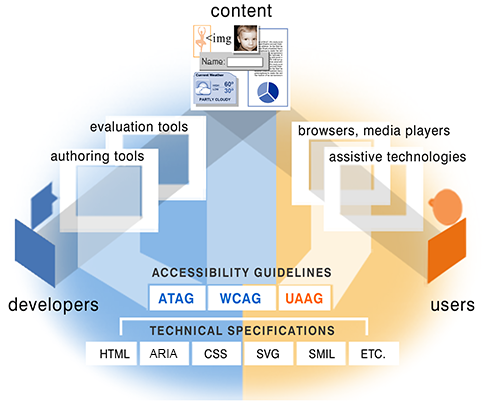Topics in this presentation
- Introduction to W3C and WAI
- How W3C develops technologies
- Current accessibility work
- Future plans
- How you can help
Introduction to W3C and WAI
World Wide Web Consortium
- Founded and directed by Tim Berners-Lee, “Inventor of the Web”
- Industry consortium managed by Team with input from Advisory Committee
- Standards support interoperability: more robust technological ecosystem
- Royalty-free standards: anyone can implement
- Detailed Process to ensure fairness and transparency
- Stewardship of accessibility, architecture, device independence, internationalization, privacy, security
Web Accessibility Initiative (WAI)
- Activities:
- Guidelines are widely referenced in corporate and national policies
- Authorized Translations facilitate worldwide adoption
How W3C develops technologies
Organization of work
Incubator Groups (XG)—being replaced by community and business groups
Role of Team
- Oversee adherence to Process
- Provide technical leadership
- Liaise with broader consortium
- Tool and administrative support
Consensus process
- Consensus: In principle, everyone should agree to a decision
- Can require lengthy discussion to explore all angles
- “Social competence in one’s role” means mature discussion of contentious issues
- Standards supported by consensus more likely to be implemented
- Can make standards development process slow, but necessary
- W3C resorts to majority vote only as very last resort
Public comments
- Instructions in “Status of this Document”
- WG must formally respond after LCWD, should before
- Groups take time to process
- Commenter acknowledgement important
- Some groups more interactive or informal than others
Accessibility stewardship
- Protocols and Formats WG (PFWG) reviews
- Provide information and resources to specification developers
- Create specifications to fill accessibility gaps
- Coordination with accessibility industry
Current accessibility work
WAI Specifications

These specifications are supported by primers, implementation guidance, techniques, etc.
Research and Development Working Group
- Accessibility knowledge contained in individual expertise and experience, anecdotal evidence
- New technology increasingly brings new types of accessibility challenges
- Research and Development Working Group (RDWG) will coordinate research in needed areas
Inreach and Outreach
- Inreach: supporting technology developers to create accessibility
- Outreach: supporting general population to implement accessibility
Future plans
New gap technology specifications
- Independent user interface for Rich Internet Applications
- Proliferation of devices that use touch as primary input
- Touch gestures vary amongst devices, and aren't accessible to all
- Need a way to respond to user intent, e.g., drag, scroll, zoom, next
page, etc.
- Replacement for DOM 3 events
- Replacement for DOM onActivate
CAPTCHA
- Inaccessibility of CAPTCHA document is becoming dated
- Machines can increasingly defeat CAPTCHAs while humans increasingly can't
- New technologies bring new problems and new solutions
- Accessibility continues to be at risk
Maintenance of existing specifications
- WCAG 2.0 is a Recommendation (final), hopefully soon ATAG 2.0 and UAAG 2.0 will be also
- Specifications not normally maintained past REC
- Above are designed to be kept current by maintaining supporting materials (understanding / implementing guidance, techniques, etc.)
- Requires ongong cyclical update from Working Groups
Track new trends
New technology constantly brings new accessibility challenges. Currently visible on the horizon:
- Geolocation
- Privacy / security
- Proliferation of APIs
… others sure to come
Towards new guidelines
- WAI’s 2.0 guidelines are designed to be relevant for a while
- As technology proliferates, need Content Technology Accessibility Guidelines to:
- Describe the accessibility features that a content technology must provide
- Recommend best practices to incorporate accessibility features optimally
- Reference research-based use cases for accessibility
- Ultimately may need to update the 2.0 guidance
- Considering a less modular approach than content, authoring tools, and user agents
- No clear directions yet, awaiting completion of all 2.0 versions and emergence of new trends
How you can help
Communities of knowledge
There are various:
- Viewpoints on accessibility challenges
- Solutions for accessibility challenges
- Requirements that must interface with accessibility requirements
These are held by:
- User interface designers
- graphical designers
- tool implementers
- assistive technology developers
- large site developers
- small site developers
- … etc.
Need to connect these communities to address accessibility holistically.
Public reviews
- Pubic feedback is a cornerstone of W3C process
- You can comment on any draft at any time
- Feedback most effective on drafts up to Last Call, within published review timeline
- WAI Interest Group announces reviews of interest
- W3C home page lists all review opportunities


Community and Business groups
- Community and Business groups are easy to form
- Can allow you to explore items of interest with others of like mind
- Minimal participation, process, and patent obligations
- Outputs can inform future W3C specifications
- Critical mass may exist here to form some…
Organizational liaisons
- W3C forms liaisons with many organizations
- Allows coordination on topics of interest
- Consider your organization for this type of relationship



